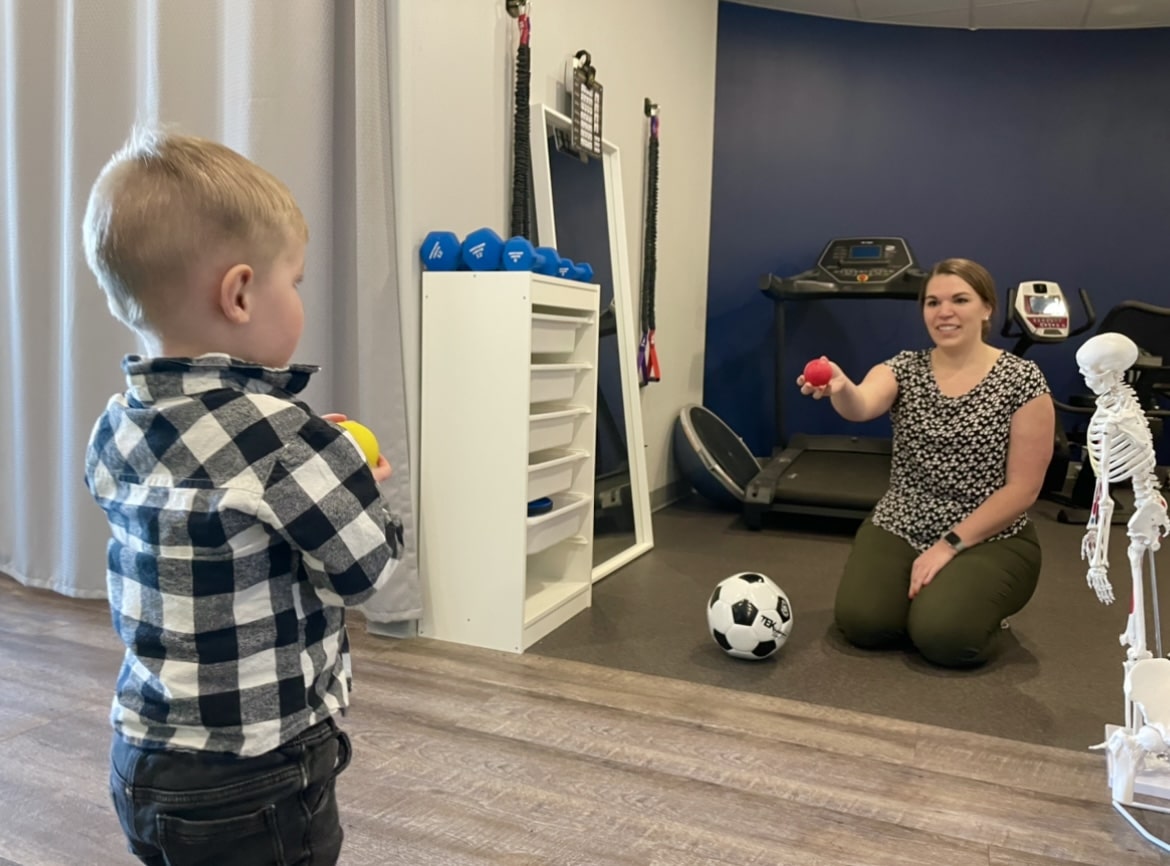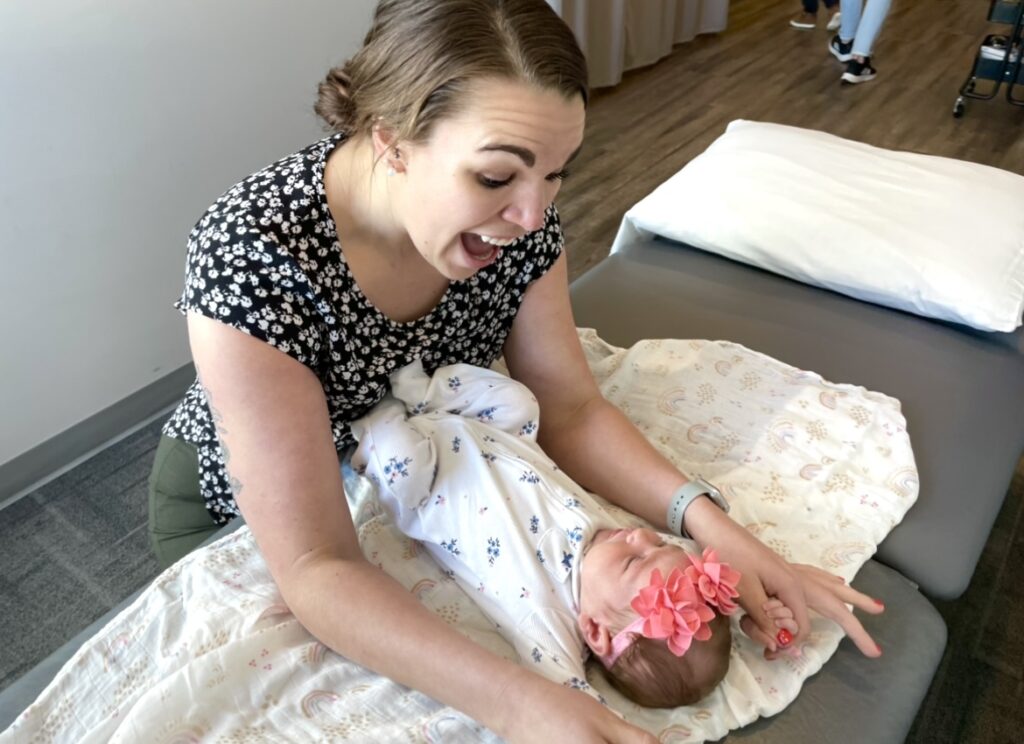3 Common Paediatric Conditions that Physiotherapy can Help!
By: Devan Mercereau, Physiotherapist
When we think of physiotherapy, we often think of it as a treatment for older teens or adults. Physiotherapy is most known for treating injuries, helping you recover from surgery, or assist with general rehabilitation. While these are all true, physiotherapy can also help infants! It is called “Paediatric Physiotherapy” and we practice this at Stride! I am a physiotherapist and I have a special interest in Paediatric Physiotherapy. Because of this, I often get asked how my treatments can help babies. So, let’s talk about it! Here are three common conditions we see in babies, and how physiotherapy is able to help!
#1: Delayed Developmental Milestones
Developmental milestones are important for many reasons. Firstly, milestones help to give infants a sense of awareness of space, which then helps them transition into different positions. Secondly, as babies grow, they improve their core and muscle strength. Thirdly, developmental milestones increase a baby’s overall independence. There are many stages of development within the first two years that are outlined here. Some common examples include:
– Holding their head up
– Rolling over
– Sitting up, crawling
– Standing and walking
It is important for infants to reach each milestone throughout their early development. From time to time, most parents worry about their baby’s growth being delayed, but it’s good to remember that not all babies are the same. For this reason, sometimes delays are okay. That being said, we do not want them to get too far behind. Physiotherapists can help and encourage your baby to reach their milestones.
During a Paediatric Physiotherapy appointment, a few things happen. Firstly, your therapist will go through your baby’s milestone development, and make an assessment of your baby’s progress based on how old they are. Secondly, you will learn tips and tricks to help your baby reach these stages at home. Thirdly, you will receive an email with alternate positions, props, and carrying methods to physically help your child reach the important stages of their development.
#2: Brachycephaly/Plagiocephaly
These long words can be overwhelming, but they sound scarier than they are! In fact, these two conditions are very common in infants. Furthermore, they can be very manageable! To start, brachycephaly and plagiocephaly rarely affect your infant’s brain development, nor milestone progression. In general, these conditions improve over time. (5) So, what are they?
Brachycephaly is the result of the back of a baby’s head becoming flat. This condition often occurs when a baby spends a lot of time on their back. (Commonly due to sleeping.) (4).
Plagiocephaly is when one side of the back of a baby’s head becomes flat. In this situation, changes in the symmetry of the eyes and ears can occur.
The first thing to remember is that these two conditions very rarely affect your baby’s brain development. So, take a breath of relief! The soft spots in your baby’s skill, called “fontanelle,” have not fused together. Therefore, the brain still has the capacity to grow! These soft spots typically fuse together between 18 months and 2 years of age. (1)
Generally, these two conditions are noticed in a baby’s first few months of life. As we know, infants sleep a lot! So this isn’t a big surprise. In this case, it is important to encourage your baby to try tummy time, side lying, or supportive sitting. When your baby moves more, they will spend less time on their back. Subsequently, there is less pressure on their skull, and their flat spots can improve over time.
During your baby’s physiotherapy visit, you will learn different resting positions for them to try. Then you will go home with a list of play positions that will help to prevent your baby’s head shape from changing.
#3: Torticollis
Torticollis is the third most common musculoskeletal condition in infants. (2) Torticollis is caused by increased muscle tone in the largest muscle in the front of the neck, which is called the sternocleidomastoid muscle. (SCM.) This large muscle does two things. Firstly, the SCM allows the neck to bend. Secondly, it supports the neck for side rotation. When Torticollis present, parents often notice their baby’s neck tends to always be tilted, and looking in one direction. This tenderness causes babies to struggle with nursing from one side.
With a tight SCM, a baby’s head will bend towards the tight side, and then rotate away from the pain. Physiotherapy treatments for this condition may include gentle massage to the SCM and other neck muscles. Of course, we also provide education! We teach parents:
– Alternative strategies to encourage looking in the opposite direction.
– Carrying positions for their baby’s safety and comfort.
– Gentle home stretching techniques.
If you are concerned about your baby’s development, or have any questions about their milestones, reach out to our clinic in Red Deer! You can book an appointment online with one of our Paediatric Physiotherapists by clicking here.
Resources
- “Anatomy of the Newborn Skull.” n.d. Stanford Children’s Health. Accessed December 31, 2021. https://www.stanfordchildrens.org/en/topic/default?id=anatomy-of-the-newborn-skull-90-P01840.
- Chen, Qiyu. n.d. “Congenital torticollis.” Physiopedia. Accessed December 30, 2021. https://www.physio-pedia.com/Congenital_torticollis.
- Mohammed, Layla. n.d. “Developmental Milestones.” CS Mott Children’s Hospital. Accessed December 30, 2021. https://www.mottchildren.org/posts/your-child/developmental-milestones.
- “PEDIATRICS.” n.d. APTA Pediatrics. Accessed December 30, 2021. https://pediatricapta.org/includes/fact-sheets/pdfs/Plagiocephaly.pdf.
- “Plagiocephaly and brachycephaly (flat head syndrome).” n.d. NHS. Accessed December 31, 2021. https://www.nhs.uk/conditions/plagiocephaly-brachycephaly/.





